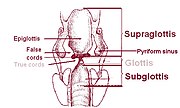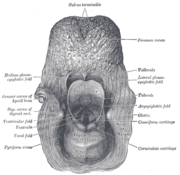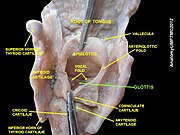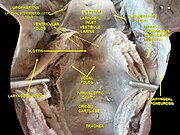Phonetics is a branch of linguistics that studies how humans produce and perceive sounds, or in the case of sign languages, the equivalent aspects of sign. Linguists who specialize in studying the physical properties of speech are phoneticians. The field of phonetics is traditionally divided into three sub-disciplines based on the research questions involved such as how humans plan and execute movements to produce speech, how various movements affect the properties of the resulting sound, or how humans convert sound waves to linguistic information. Traditionally, the minimal linguistic unit of phonetics is the phone—a speech sound in a language which differs from the phonological unit of phoneme; the phoneme is an abstract categorization of phones, and it is also defined as the smallest unit that discerns meaning between sounds in any given language.

In articulatory phonetics, the place of articulation of a consonant is a location along the vocal tract where its production occurs. It is a point where a constriction is made between an active and a passive articulator. Active articulators are organs capable of voluntary movement which create the constriction, while passive articulators are so called because they are normally fixed and are the parts with which an active articulator makes contact. Along with the manner of articulation and phonation, the place of articulation gives the consonant its distinctive sound.
The term phonation has slightly different meanings depending on the subfield of phonetics. Among some phoneticians, phonation is the process by which the vocal folds produce certain sounds through quasi-periodic vibration. This is the definition used among those who study laryngeal anatomy and physiology and speech production in general. Phoneticians in other subfields, such as linguistic phonetics, call this process voicing, and use the term phonation to refer to any oscillatory state of any part of the larynx that modifies the airstream, of which voicing is just one example. Voiceless and supra-glottal phonations are included under this definition.

The human voice consists of sound made by a human being using the vocal tract, including talking, singing, laughing, crying, screaming, shouting, humming or yelling. The human voice frequency is specifically a part of human sound production in which the vocal folds are the primary sound source.

The larynx, commonly called the voice box, is an organ in the top of the neck involved in breathing, producing sound and protecting the trachea against food aspiration. The opening of larynx into pharynx known as the laryngeal inlet is about 4–5 centimeters in diameter. The larynx houses the vocal cords, and manipulates pitch and volume, which is essential for phonation. It is situated just below where the tract of the pharynx splits into the trachea and the esophagus. The word 'larynx' comes from the Ancient Greek word lárunx ʻlarynx, gullet, throat.ʼ
The field of articulatory phonetics is a subfield of phonetics that studies articulation and ways that humans produce speech. Articulatory phoneticians explain how humans produce speech sounds via the interaction of different physiological structures. Generally, articulatory phonetics is concerned with the transformation of aerodynamic energy into acoustic energy. Aerodynamic energy refers to the airflow through the vocal tract. Its potential form is air pressure; its kinetic form is the actual dynamic airflow. Acoustic energy is variation in the air pressure that can be represented as sound waves, which are then perceived by the human auditory system as sound.

The glottal stop or glottal plosive is a type of consonantal sound used in many spoken languages, produced by obstructing airflow in the vocal tract or, more precisely, the glottis. The symbol in the International Phonetic Alphabet that represents this sound is ⟨ʔ⟩.

The alveolar and dental ejective stops are types of consonantal sound, usually described as voiceless, that are pronounced with a glottalic egressive airstream. In the International Phonetic Alphabet, ejectives are indicated with a "modifier letter apostrophe" ⟨ʼ⟩, as in this article. A reversed apostrophe is sometimes used to represent light aspiration, as in Armenian linguistics ⟨p‘ t‘ k‘⟩; this usage is obsolete in the IPA. In other transcription traditions, the apostrophe represents palatalization: ⟨pʼ⟩ = IPA ⟨pʲ⟩. In some Americanist traditions, an apostrophe indicates weak ejection and an exclamation mark strong ejection: ⟨k̓, k!⟩. In the IPA, the distinction might be written ⟨kʼ, kʼʼ⟩, but it seems that no language distinguishes degrees of ejection.

The uvular ejective is a type of consonantal sound, used in some spoken languages. The symbol in the International Phonetic Alphabet that represents this sound is ⟨qʼ⟩.
The voiceless glottal fricative, sometimes called voiceless glottal transition or the aspirate, is a type of sound used in some spoken languages that patterns like a fricative or approximant consonant phonologically, but often lacks the usual phonetic characteristics of a consonant. The symbol in the International Phonetic Alphabet that represents this sound is ⟨h⟩, and the equivalent X-SAMPA symbol is h. However, has been described as a voiceless vowel because in many languages, it lacks the place and manner of articulation of a prototypical consonant, as well as the height and backness of a prototypical vowel:
[h and ɦ] have been described as voiceless or breathy voiced counterparts of the vowels that follow them [but] the shape of the vocal tract [...] is often simply that of the surrounding sounds. [...] Accordingly, in such cases it is more appropriate to regard h and ɦ as segments that have only a laryngeal specification, and are unmarked for all other features. There are other languages [such as Hebrew and Arabic] which show a more definite displacement of the formant frequencies for h, suggesting it has a [glottal] constriction associated with its production.
In phonetics, the airstream mechanism is the method by which airflow is created in the vocal tract. Along with phonation and articulation, it is one of three main components of speech production. The airstream mechanism is mandatory for most sound production and constitutes the first part of this process, which is called initiation.

A pharyngeal consonant is a consonant that is articulated primarily in the pharynx. Some phoneticians distinguish upper pharyngeal consonants, or "high" pharyngeals, pronounced by retracting the root of the tongue in the mid to upper pharynx, from (ary)epiglottal consonants, or "low" pharyngeals, which are articulated with the aryepiglottic folds against the epiglottis at the entrance of the larynx, as well as from epiglotto-pharyngeal consonants, with both movements being combined.
In phonetics, a glottalic consonant is a consonant produced with some important contribution of the glottis.

The palatal ejective is a type of consonantal sound used in some spoken languages. The symbol in the International Phonetic Alphabet that represents this sound is ⟨cʼ⟩.
A voiceless uvular implosive is a rare consonantal sound, used in some spoken languages. The symbol in the International Phonetic Alphabet that represents this sound is ⟨ʛ̥ ⟩ or ⟨qʼ↓⟩. A dedicated IPA letter, ⟨ʠ⟩, was withdrawn in 1993.
A voiceless palatal implosive is a rare consonantal sound, used in some spoken languages. The symbol in the International Phonetic Alphabet that represents this sound is ⟨ ʄ̊ ⟩ or ⟨cʼ↓⟩. A dedicated IPA letter, ⟨ƈ⟩, was withdrawn in 1993.

A voiceless bilabial implosive is a rare consonantal sound, used in some spoken languages. The symbol in the International Phonetic Alphabet that represents this sound is ⟨ɓ̥⟩ or ⟨pʼ↓⟩. A dedicated IPA letter, ⟨ƥ⟩, was withdrawn in 1993.
A voiceless alveolar implosive is a rare consonantal sound, used in some spoken languages. The symbol in the International Phonetic Alphabet that represents this sound is ⟨ɗ̥⟩ or ⟨tʼ↓⟩. A dedicated IPA letter, ⟨ƭ⟩, was withdrawn in 1993.
A voiceless velar implosive is a very rare consonantal sound. The symbol for this sound in the International Phonetic Alphabet is ⟨ɠ̊⟩ or ⟨kʼ↓⟩. A dedicated IPA letter, ⟨ƙ⟩, was withdrawn in 1993.
The epiglottal or pharyngeal ejective is a rare type of consonantal sound, used in some spoken languages. The symbol in the International Phonetic Alphabet that represents this sound is ⟨ʡʼ⟩.
















